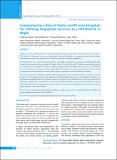Please use this identifier to cite or link to this item:
https://hdl.handle.net/20.500.14356/1245Full metadata record
| DC Field | Value | Language |
|---|---|---|
| dc.contributor.author | Kharal, Puspa Mani | - |
| dc.contributor.author | Bhattarai, Prakriti | - |
| dc.contributor.author | Bhattarai, Prithutam | - |
| dc.contributor.author | Thapa, Shyam | - |
| dc.date.accessioned | 2023-05-03T08:41:22Z | - |
| dc.date.available | 2023-05-03T08:41:22Z | - |
| dc.date.issued | 2020 | - |
| dc.identifier.citation | KharalP. M., BhattaraiP., BhattaraiP., & ThapaS. (2020). Complementary Role of Public and Private Hospitals for Utilizing Outpatient Services in a Hill District in Nepal. Journal of Nepal Health Research Council, 18(2), 178-185. https://doi.org/10.33314/jnhrc.v18i2.2711 | en_US |
| dc.identifier.issn | Print ISSN: 1727-5482; Online ISSN: 1999-6217 | - |
| dc.identifier.uri | http://103.69.126.140:8080/handle/20.500.14356/1245 | - |
| dc.description | Original Article | en_US |
| dc.description.abstract | Abstract Background: In Nepal, the private sector has prominently emerged as a provider of health services in recent years. The objective of this paper is to assess whether public and private hospitals are competing for patients with similar socioeconomic strata, or providing services to different segments of the patient population. Methods: Data were collected prospectively from one public hospital and one private-for-profit hospital, both located in close proximity to one another in Tanahu district. A total of 384 and 389 patients presenting themselves for outpatient services available at the district public hospital and a private hospital, respectively, were systematically selected and interviewed using a survey form. The profiles of the patients were comparatively analyzed, and the reasons for using a particular hospital were assessed. Binary logistic regression was used for multivariate analysis. Results: Compared to the patients using the public hospital, patients at the private hospital were younger, possessed a higher level of education, represented indigenous and disadvantaged ethnic groups, and belonged to business or agricultural occupations. The four prominent reasons for using the private hospital were: positive perception/prior experience, followed by recommendation/word-of-mouth, timely availability of services, and trustworthiness. Among the public hospital patients, the prominent reasons were: low fee for services or having insurance, positive perception/prior experience, and trustworthiness. Conclusions: Public and private hospitals have played a complementary role in serving the health needs of different patient population segments in the study district. Keywords: Nepal; private hospital; public hospital; reasons for use; users profile. | en_US |
| dc.language.iso | en | en_US |
| dc.publisher | Nepal Health Research Council | en_US |
| dc.relation.ispartofseries | Apr-June, 2020;2711 | - |
| dc.subject | Nepal | en_US |
| dc.subject | private hospital | en_US |
| dc.subject | public hospital | en_US |
| dc.subject | reasons for use | en_US |
| dc.subject | users profile | en_US |
| dc.title | Complementary Role of Public and Private Hospitals for Utilizing Outpatient Services in a Hill District in Nepal | en_US |
| dc.type | Journal Article | en_US |
| local.journal.category | Original Article | - |
| Appears in Collections: | Vol. 18 No. 2 Issue 47 Apr-Jun 2020 | |
Files in This Item:
| File | Description | Size | Format | |
|---|---|---|---|---|
| 2711-Manuscript-17510-1-10-20200911.pdf | Fulltext Download | 292.63 kB | Adobe PDF |  View/Open |
Items in DSpace are protected by copyright, with all rights reserved, unless otherwise indicated.
